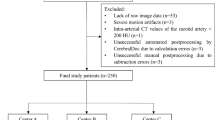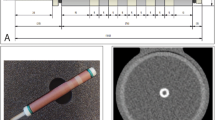Abstract
The purpose of this study is to demonstrate the appearance of traumatic aortic injuries with the novel 3-dimensional (3D) computed tomography (CT) visualization technique known as cinematic rendering (CR). CR uses a novel lighting model to create photorealistic images with excellent anatomic detail for improved depiction of the extent of traumatic aortic injuries. Four patients with acute traumatic aortic injury identified on thoracic CT angiography were analyzed by creating standard 3D volume-rendered reconstructions and CR images on an independent 3D workstation. In this series of four patients, we present the typical patterns of aortic injury imaging findings and complications associated with traumatic aortic injury, with an emphasis on the utilization of the novel 3D technique of CR. CR can provide realistic imaging of the thoracic aortic contour with excellent spatial details. This methodology allows for an accurate assessment of aortic injury and optimal preoperative planning in patients with traumatic thoracic aortic injury.




Similar content being viewed by others
References
Parmley L, Thomas W, Manion W, Jahnke E (1958) Non-penetrating traumatic injury of the aorta. Circulation 17:1086–1101
Ueda T, Chin A, Petrovitch I, Fleischmann D (2012) A pictorial review of acute aortic syndrome: discriminating and overlapping features as revealed by ECG-gated multidetector-row CT angiography. Insights Imaging 3:561–571
Chaikof EL, Dalman RL, Eskandari MK, Jackson BM, Lee WA, Mansour MA, Mastracci TM, Mell M, Murad MH, Nguyen LL, Oderich GS, Patel MS, Schermerhorn ML, Starnes BW (2018) The Society for Vascular Surgery practice guidelines on the care of patients with an abdominal aortic aneurysm. J Vasc Surg 67(1):2-77 e72. https://doi.org/10.1016/j.jvs.2017.10.044
Hiratzka LF, Bakris GL, Beckman JA, Bersin RM, Carr VF, Casey DE Jr, Eagle KA, Hermann LK, Isselbacher EM, Kazerooni EA, Kouchoukos NT, Lytle BW, Milewicz DM, Reich DL, Sen S, Shinn JA, Svensson LG, Williams DM (2010) 2010 ACCF/AHA/AATS/ACR/ASA/SCA/SCAI/SIR/STS/SVM guidelines for the diagnosis and management of patients with thoracic aortic disease. A report of the American College of Cardiology Foundation/American Heart Association Task Force on Practice Guidelines, American Association for Thoracic Surgery, American College of Radiology, American Stroke Association, Society of Cardiovascular Anesthesiologists, Society for Cardiovascular Angiography and Interventions, Society of Interventional Radiology, Society of Thoracic Surgeons, and Society for Vascular Medicine. J Am Coll Cardiol 55(14):e27–e129. https://doi.org/10.1016/j.jacc.2010.02. 015
Iezzi R, Santoro M, Dattesi R, Pirro F, Nestola M, Spigonardo F, Cotroneo AR, Bonomo L (2012) Multi-detector CT angiographic imaging in the follow-up of patients after endovascular abdominal aortic aneurysm repair (EVAR). Insights Imaging 3(4):313–321. https://doi.org/10.1007/s13244-012-0173-0
Bean MJ, Johnson PT, Roseborough GS, Black JH, Fishman EK (2008) Thoracic aortic stent-grafts: utility of multidetector CT for pre- and postprocedure evaluation. Radiographics: Rev Publ Radiol Soc N Am, Inc 28 (7):1835–1851. https://doi.org/10.1148/rg.287085055
Rowe SP, Johnson PT, Fishman EK (2018) Cinematic rendering of cardiac CT volumetric data: principles and initial observations. J Cardiovasc Comput Tomogr 12(1):56–59. https://doi.org/10.1016/j.jcct.2017.11.013
Rowe SP, Johnson PT, Fishman EK (2018) Initial experience with cinematic rendering for chest cardiovascular imaging. Br J Radiol 91(1082):20170558. https://doi.org/10.1259/bjr.20170558
Johnson PT, Schneider R, Lugo-Fagundo C, Johnson MB, Fishman EK (2017) MDCT angiography with 3D rendering: a novel cinematic rendering algorithm for enhanced anatomic detail. AJR Am J Roentgenol 209(2):309–312. https://doi.org/10.2214/AJR.17.17903
Blum A, Gillet R, Rauch A, Urbaneja A, Biouichi H, Dodin G, Germain E, Lombard C, Jaquet P, Louis M, Simon L, Gondim Teixeira P (2020) 3D reconstructions, 4D imaging and postprocessing with CT in musculoskeletal disorders: past, present and future. Diagn Interv Imaging 101(11):693–705. https://doi.org/10.1016/j.diii.2020.09.008
Orozco-Sevilla V, Weldon SA, Coselli JS (2018) Hybrid thoracoabdominal aortic aneurysm repair: is the future here? J Vis Surg 4:61. https://doi.org/10.21037/jovs.2018.02.14
Steenburg SD, Ravenel JG (2008) Acute traumatic thoracic aortic injuries: experience with 64-MDCT. AJR Am J Roentgenol 191(5):1564–1569
Zimmerman SL, Rowe SP, Fishman EK (2021) Cinematic rendering of CT angiography for visualization of complex vascular anatomy after hybrid endovascular aortic aneurysm repair. Emerg Radiol 28(4):839–843. https://doi.org/10.1007/s10140-021-01922-5. Epub 2021 Mar 2. PMID: 33651233
Rowe SP, Johnson PT, Fishman EK (2018) MDCT of ductus diverticulum: 3D cinematic rendering to enhance understanding of anatomic configuration and avoid misinterpretation as traumatic aortic injury. Emerg Radiol 25(2):209–213. https://doi.org/10.1007/s10140-018-1578-y
Author information
Authors and Affiliations
Corresponding author
Ethics declarations
Conflict of interest
Abdullah Al Khalifah: nothing to disclose.
Stefan Zimmerman:
-
MRI online: advisory board, faculty honoraria
-
Bayer Healthcare: research funding
-
Siemens Healthcare: partial salary support for clinical consultation
Elliot Fishman:
-
Siemens: research support
-
GE: research support
-
HipGraphics, Inc.: co-founder
-
Imaging Endpoints: advisory board
Additional information
Publisher's note
Springer Nature remains neutral with regard to jurisdictional claims in published maps and institutional affiliations.
Rights and permissions
Springer Nature or its licensor holds exclusive rights to this article under a publishing agreement with the author(s) or other rightsholder(s); author self-archiving of the accepted manuscript version of this article is solely governed by the terms of such publishing agreement and applicable law.
About this article
Cite this article
Al Khalifah, A., Zimmerman, S.L. & Fishman, E.K. Visualization of acute aortic injury with cinematic rendering. Emerg Radiol 29, 1043–1048 (2022). https://doi.org/10.1007/s10140-022-02086-6
Received:
Accepted:
Published:
Issue Date:
DOI: https://doi.org/10.1007/s10140-022-02086-6




